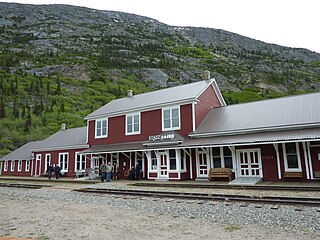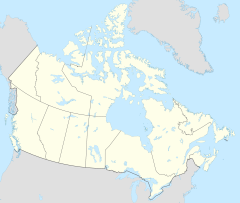
The Klondike Gold Rush was a migration by an estimated 100,000 prospectors to the Klondike region of Yukon, in north-western Canada, between 1896 and 1899. Gold was discovered there by local miners on August 16, 1896; when news reached Seattle and San Francisco the following year, it triggered a stampede of prospectors. Some became wealthy, but the majority went in vain. It has been immortalized in films, literature, and photographs.

Dawson City, officially the City of Dawson, is a town in the Canadian territory of Yukon. It is inseparably linked to the Klondike Gold Rush (1896–99). Its population was 1,375 as of the 2016 census, making it the second-largest town in Yukon.

Joseph Juneau was a Canadian miner and prospector who was born in the Lower Canada town of Saint-Paul-l'Ermite to François Xavier Juneau dit Latulippe and Marguerite Thiffault Juneau. He is best known for co-founding, with Richard Harris, the city of Juneau, Alaska, United States. The first major gold discovery in Juneau, on Douglas Island, occurred circa 1880. The city has been the political capital of Alaska since 1900.

The Chilkoot Trail is a 33-mile (53 km) trail through the Coast Mountains that leads from Dyea, Alaska, in the United States, to Bennett, British Columbia, in Canada.

Bennett, British Columbia, Canada, is an abandoned town next to Bennett Lake and along Lindeman Creek. The townsite is now part of the Chilkoot Trail National Historic Site of Canada and is managed by Parks Canada. Bennett is also a stop on the White Pass and Yukon Route railroad during the summer months.

Klondike Gold Rush National Historical Park is a national historical park operated by the National Park Service that seeks to commemorate the Klondike Gold Rush of the late 1890s. Though the gold fields that were the ultimate goal of the stampeders lay in the Yukon Territory, the park comprises staging areas for the trek there and the routes leading in its direction. There are four units, including three in Municipality of Skagway Borough, Alaska and a fourth in the Pioneer Square National Historic District in Seattle, Washington.

The Yukon Field Force, later termed the Yukon Garrison, was a unit of 203 officers and men from the Permanent Force of the Canadian Militia that served in the Yukon between 1898 and 1900. The force was created in the wake of the Klondike Gold Rush in response to fears that the United States might attempt to seize the region. It left Ottawa on May 6, 1898, travelling by rail and sea to the port of Glenora in British Columbia. From there, the unit made an arduous journey of 890 kilometres (550 mi) on foot and using makeshift boats to Fort Selkirk, where they established their headquarters. A detachment of 72 men was sent to the boom town of Dawson City to support the North-West Mounted Police, with duties that included guarding the gold deposits of the local banks. As the fears of an annexation reduced, pressures grew for the recall of the force. The force was halved in size in July 1898 and the remainder were finally withdrawn in June 1900.

A roadhouse or stopping house (Canada) is a small mixed-use premises typically built on or near a major road in a sparsely populated area or an isolated desert region that services the passing travellers, providing food, drinks, accommodation, fuel, and parking spaces to the guests and their vehicles. The premises generally consist of just a single dwelling, permanently occupied by a nuclear family, usually between two and five family members.

Alexander "Big Alex" McDonald (1859–1909) was a Canadian gold prospector who made a fortune in the Klondike Gold Rush, earning himself the title "King of the Klondike".

Belinda Mulrooney (1872–1967) was an entrepreneur and purportedly the "richest woman in the Klondike". She made one fortune in the Klondike Gold Rush, lost it, and amassed a second, which lasted most of the rest of her life.

The Nome Gold Rush was a gold rush in Nome, Alaska, approximately 1899–1909. It is separated from other gold rushes by the ease with which gold could be obtained. Much of the gold was lying in the beach sand of the landing place and could be recovered without any need for a claim. Nome was a sea port without a harbor, and the biggest town in Alaska.
The Klondike Gold Rush is commemorated through film, literature, historical parks etc.
Thomas William O'Brien was a Klondike gold rush entrepreneur who was best known for his Klondike Mines Railway and Klondike brewery businesses. He was also elected as a member of the Yukon Territorial Council, and was the first president of the Yukon Order of Pioneers, Klondike Lodge.
The O'Brien Brewing and Malting Company, also known as the Klondike Brewery, was a brewery founded by Thomas O'Brien in Klondike City, an adjoining settlement to Dawson City, Yukon Territory, Canada from 1904 to 1919. It was established during a period in which Dawson City was expected to become an important regional city, and used modern techniques and equipment imported from California. It was initially successful, selling 68,748 gallons of beer in 1905, but Dawson's population declined and growing temperance attitudes threatened the business. O'Brien sold the company in 1915, and in 1919 prohibition forced its closure. The brewery was abandoned, and the remains of the site are now owned by the Tr'ondek Hwech'in First Nation.

Michael "Black Mike" Winage was a Serbian Canadian miner, pioneer and adventurer who settled in the Yukon towards the end of the Klondike Gold Rush and who allegedly lived to be 107 years old.
Anton Stander, was a pioneer and the prospector from the great Klondike Gold Rush. He was one of the six wealthiest prospectors in Klondike.

Grand Forks is a ghost town and former community at the confluence of Bonanza Creek and Eldorado Creek in Yukon. First settled about 1896, it became the second-largest settlement in the Klondike. With approximately 10,000 people lived in or by Grand Forks during the Klondike Gold Rush, it was the only community besides Dawson City to have a municipal government. The Grand Forks Hotel was a roadhouse here during the gold rush.

Discovery Claim is a mining claim at Bonanza Creek, a watercourse in the Yukon, Canada. It is the site where, in the afternoon of August 16, 1896, the first piece of gold was found in the Yukon by prospectors. The site is considered to be the place where the Klondike gold rush started. It is located around 17 km south-southeast of Dawson City. The Discovery claim was designated a National Historic Site of Canada on July 13, 1998.

Dredge No. 4 is a wooden-hulled bucketline sluice dredge that mined placer gold on the Yukon River from 1913 until 1959. It is now located along Bonanza Creek Road 13 kilometres (8.1 mi) south of the Klondike Highway near Dawson City, Yukon, where it is preserved as one of the National Historic Sites of Canada. It is the largest wooden-hulled dredge in North America.

The history of the North-West Mounted Police in the Canadian north describes the activities of the North-West Mounted Police in the North-West Territories at the end of the 19th century and the start of the 20th. The mounted police had been established to control the prairies along the Canadian-United States border in 1873, but were then also deployed to control the Yukon region during the Klondike Gold Rush, and subsequently expanded their operations into the Hudson Bay area and the far north. The force was amalgamated in 1920 to form part of the new Royal Canadian Mounted Police, who continued their predecessors' work across the region.

















